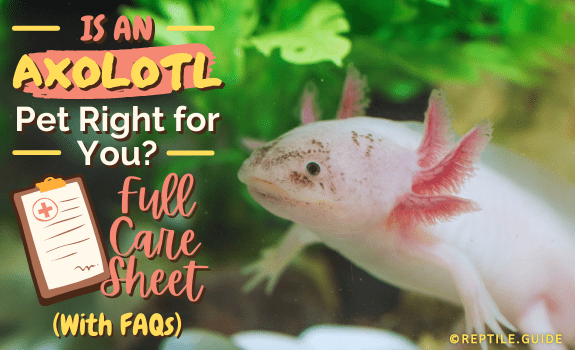The Axolotl or Mexican walking fish, scientific name Ambystoma mexicanum, is an eternal child.
Since scientists imported them in the 1800s, bearded dragons have become popular pets with beginner and expert keepers alike.
These animals are easy to keep and are perfect for most keepers.
Let’s look at the basics of axolotl pet care.
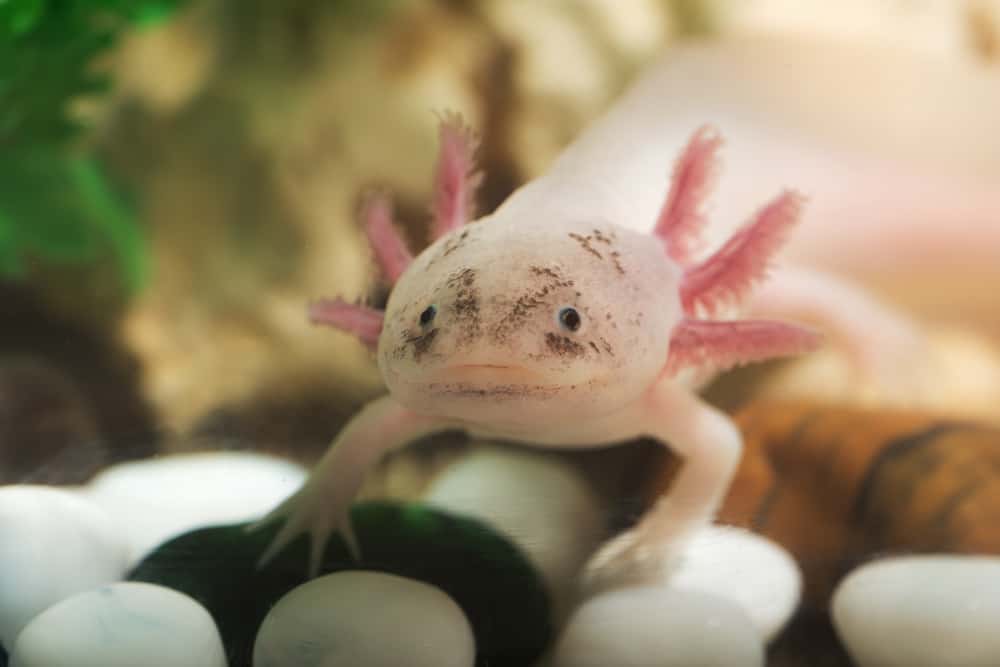
In This Article
Axolotl Background Information
Although axolotls are popular pets, we know little about their lives in the wild. Their small distribution range, and tiny population, make it difficult to study these animals in the wild.
Size and Appearance
The axolotl, Ambystoma mexicanum, is a large salamander that grows to lengths of 12 inches.
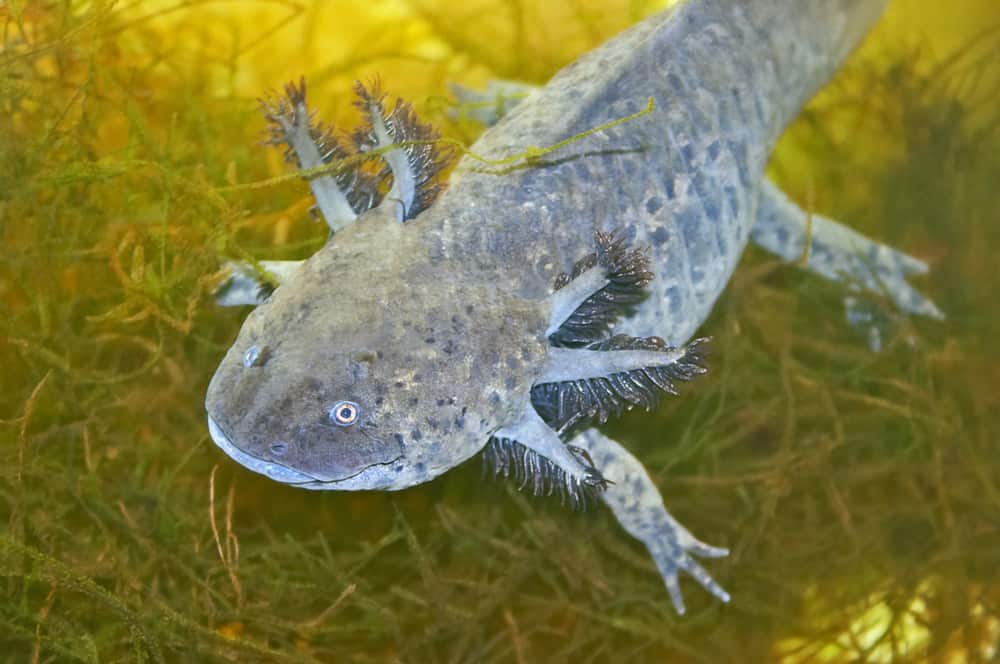
They’re neotenic, which means they retain juvenile characteristics even as adults.
Most young salamanders have feathery gills, which they absorb later on. Axolotls keep their bright pink or red gills for their entire lives.
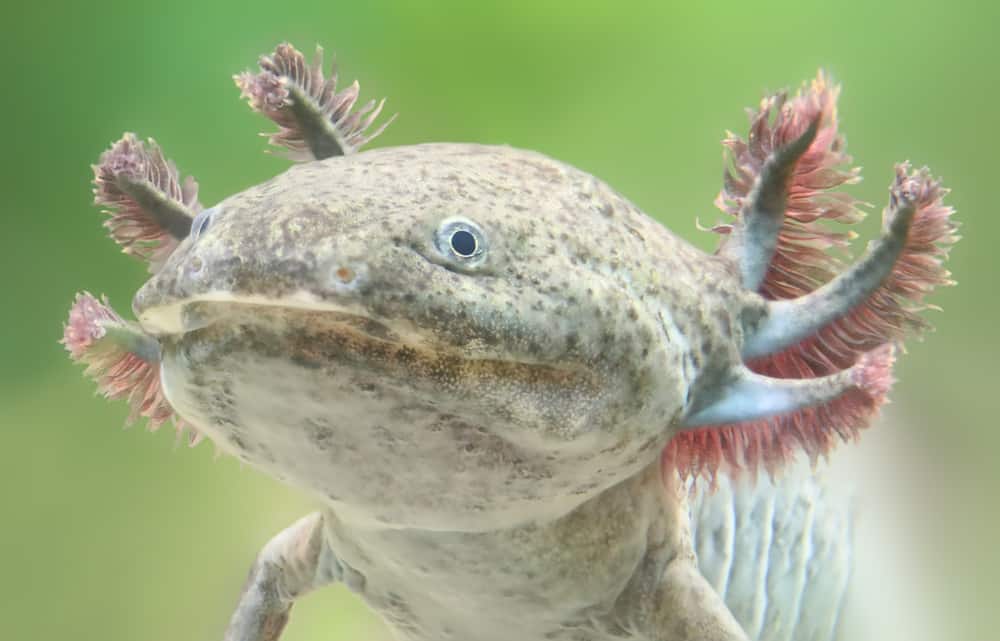
These animals have long tails and a tail fin that ends just before their heads.They also have round, shiny eyes and short, stubby legs.
Axolotl colors range from light brown to white or yellow.
Habitat and Distribution
The axolotl is a Mexican salamander that occurs in Lake Xochimilco and the canals of Mexico City.
Scientists have confirmed a third population exists in Chapultepec Lake, also in Mexico City.
These aquatic creatures once lived in Lake Chalco as well, but it’s been drained for development purposes.
Similarly, many of their passageways and streams that once connected different populations have dried up or been drained.
Axolotls prefer mountain lakes and streams with a low water temperature. Lake Xochimilco, and the canals of Mexico City, lie in a mountain basin and have low temperatures.
They live on the floor of lakes and canals, where they use their short stubby legs to walk. They can also propel themselves forward using their tail fins.
While they occasionally gulp air from the surface, they take most of their oxygen from the water using their gills.
Conservation Status
All of the axolotls in captivity today descend from a shipment sent to August Duméril in 1863.
They’re good pets that breed readily, which means they’re plentiful in captivity. In the wild, their numbers are much less.
The IUCN (International Union for the Conservation of Nature) classifies the axolotl as a critically endangered species.
The current population estimates number less than 1,000 animals.
The Convention on International Trade of Endangered Species (CITES) lists Ambystoma mexicanum as an Appendix II species.
It’s illegal to export Appendix II animals from their country of origin or import them into another country, without extensive permits.
So be sure to only buy axolotls from reputable breeders and amphibian marketplaces.
Axolotls are neotenic salamanders. Instead of the typical amphibian metamorphosis, adult axolotls look exactly like young axolotls, except bigger.
Since they can’t emerge from the water and travel overland, like their cousin the tiger salamander, axolotls are susceptible to many threats.
Some of the main factors placing axolotls at risk of extinction are:
- Water pollution
- Human encroachment (draining lakes, canals, and other water sources for development)
- Introduction of exotic fish and other predators (axolotls used to be the top predator in their habitat)
Axolotl Pet Diet
Like all salamanders and most other amphibians, axolotls are carnivorous. In the wild, they feed on inhabitants of their native lakes.
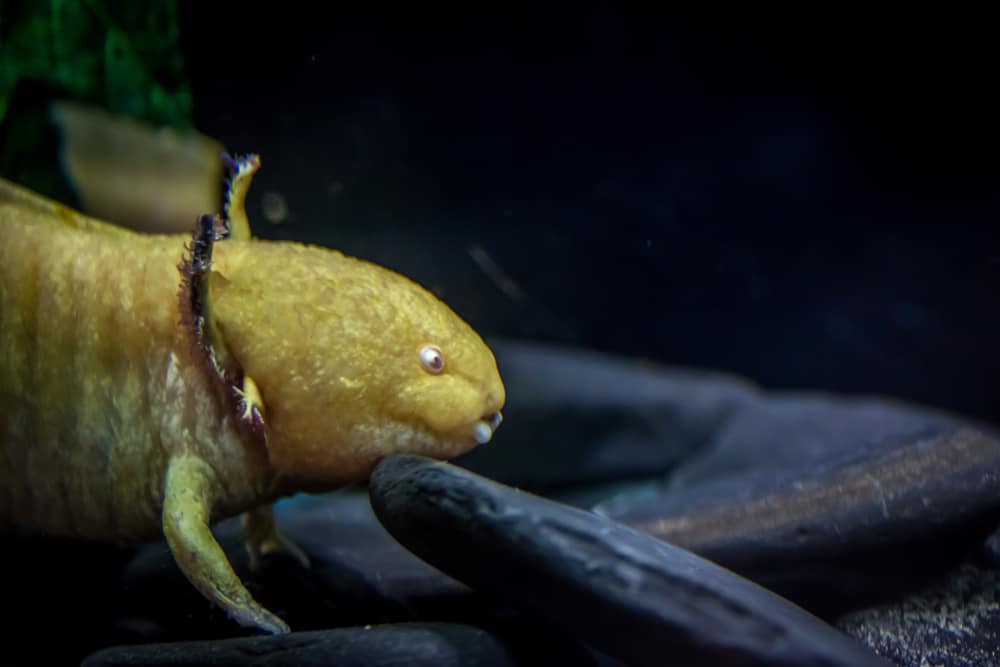
Their diet includes:
- Insects
- Mollusks
- Small fish
- Small crustaceans
Feeding them in captivity is easy, thanks to the aquarium trade. Many people keep carnivorous fish which have a similar diet to axolotls.
Some of the many feeding options for axolotls in captivity include:
- Bloodworms
- Tubifex worms
- Salmon pellets
- Feeder minnows
- Red wriggler worms
- Lean beef heart (small pieces)
- Brine shrimp (rinsed free of salt)
Baby axolotls need to eat every day, while adult axolotls eat every 3-4 days.
You can expect a juvenile axolotl to eat around four or five small worms (bloodworm or blackworm) every day.
An adult axolotl will eat around a teaspoon of worms per feeding session.
Of course, you should try to vary the food as much as possible. You can offer equivalent amounts of the other foods on the list.
Use beef heart, shrimp, and feeder minnows as occasional treats rather than staples. They’re higher in fat and can lead to obesity.
Remove any uneaten food the same day to ensure it doesn’t pollute the water.
Feel free to also check out our axolotl diet guide for more detailed information!
Axolotl Tank Setup
Axolotls are good pets and easy to keep. However, you need to set up their fish tank the right way to ensure you have a healthy axolotl.
This part of the axolotl care sheet will show you what you need.
Substrate
Many hobbyists and breeders disagree about what to use on the bottom of the tank.
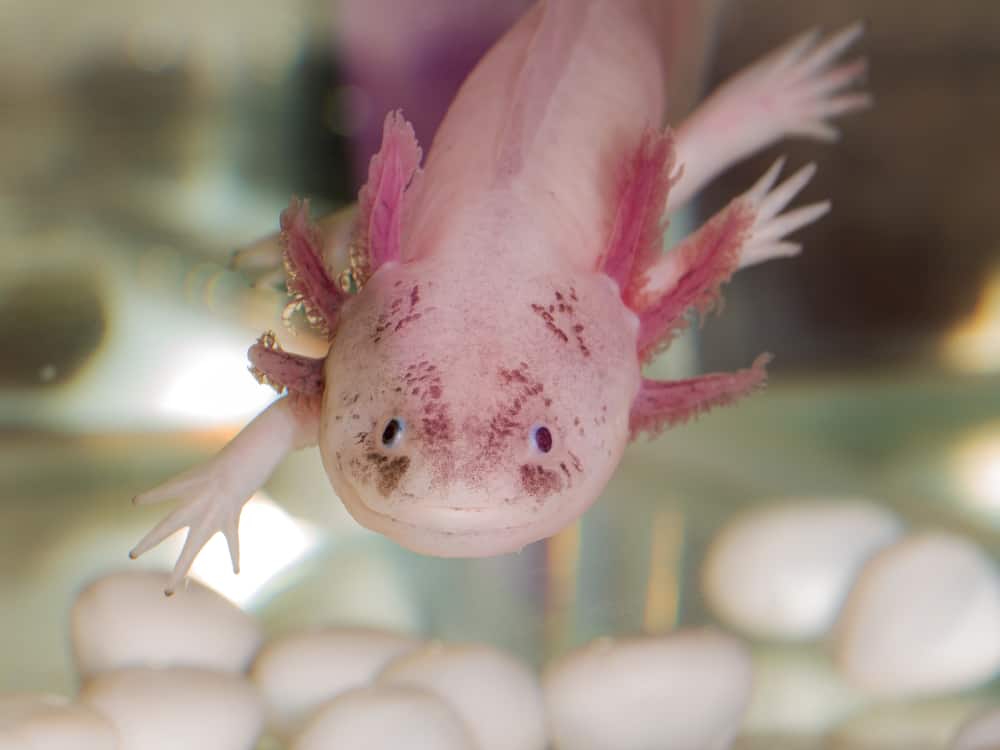
Many argue that one shouldn’t use substrate, while others claim that not having substrate is unnatural.
There are advantages and disadvantages to both sides. Bare-bottom tanks:
- Are easier to clean
- Don’t offer any choking or impaction hazards
However, they:
- Don’t give the animal a sense of security
- Don’t allow you to use an under-gravel filter
- Don’t offer grip for the axolotl to walk on the bottom (a natural behavior)
Using substrate on the bottom of the aquarium:
- Lets you incorporate an under-gravel filter
- Resembles an axolotl’s natural habitat
- Forms a natural bacterial culture that helps process nitrates
- Increases the animal’s sense of security
- Helps to absorb light (to which axolotls are sensitive)
On the other hand, substrate:
- Isn’t as easy to clean
- Can pose an impaction risk
Despite the risks, we suggest using a substrate. It has several benefits and will make your axolotl feel more secure.
Types of Substrate
Keepers use various substrates to cover the bottom of the tank, with some being more efficient than others. Let’s take a look at some of the substrates keepers have tried:
- Slate – Some keepers prefer placing a few large sheets of slate in the bottom of the aquarium. While this works, it also puts extra strain on the tank’s base.
- Fine sand – This is by far the best substrate for these animals. It gives them the grip to walk along the bottom and gives beneficial bacteria a place to multiply.
Since sand is so fine, it works through the creature’s system easily, and won’t cause an impaction. It’s also unlikely to damage the axolotl’s sensitive skin.
- River stones – Large, smooth river stones that are too large for an axolotl to swallow make a good substrate. They won’t cause an impaction, can’t injure the animal and give the axolotl grip.
Pro Tip: Never use gravel for an axolotl’s home. It has sharp edges which can cut the axolotl. The axolotl may also swallow the gravel, leading to impaction.
Heating
Water temperature is an essential part of your axolotl tank. Unlike most animals we keep in captivity, axolotls require cool water rather than warm water.
Try to maintain a water temperature of 60°F to 65°F at all times.
If you live in a warm place, this might be difficult, but there are options.
If a short-term heat spike is a problem, you can try the following:
- Turn off the lights, if you have any.
- Place a sealed zip-lock bag, with three or four ice cubes in it, in the aquarium.
- Remove the hood, and cover the axolotl tank with a mesh layer. Heat rises, so the heat will escape through the open top.
- Siphon some of the water from the aquarium (the motion cools it down), then pump it back or replace it with slightly cooler water.
It’s essential that you only cool down the temperatures in segments of 2-3°F degrees at a time (2°F every 20 minutes).
Cooling down the water in a sudden rush can send axolotls into shock.
In most parts of the world, it’s unlikely that the tank will have a 60-65°F temperature for more than a few months a year.
In these cases, you need a more permanent solution. The easiest option for most people is to cool the entire room down.
Most homes have central heating and air conditioners. Many people choose to have a cool room where they keep the axolotl and possibly house their coldwater fish there as well.
However, that’s not always a viable option. In such a scenario, a Peltier cooling system is one of the best bets.
This unique cooling system runs by either creating or removing heat. They’re small devices that have found application in the refrigeration industry for years.
You can choose to buy a pre-built model or to do some research and build your own from the base parts. You’ll need a thermostat with a thermometer to keep the water in range.
Lighting
Like most other species of salamander, axolotls prefer dark enclosures.
So don’t install a light in their tank. The only good reason to add light to your pet’s home is if you want to grow live plants.
If you decide to go that route, choose plants that can live in low light conditions. Doing so will allow you to choose a full-spectrum light that doesn’t shine too bright.
You can also consider buying a nighttime bulb. These lights simulate moonlight, and won’t disturb your axolotl.
Filtration
Filtration is essential for keeping the tank water quality up. Since axolotls are carnivores, they produce a lot of nitrates and ammonia in their waste.
There are many potential filtration setups, and you can talk to the staff at local aquarium stores if you’d like additional guidance.
There are three main types of filters:
- Canister filters – Canister filters are strong filtration devices that push the water through several layers of filter media.
They’re one of the filters that clean the best, but they also have a high output. Axolotls come from calm water sources and don’t appreciate the force of a canister filter.
If you use one of these, you’ll need to install it carefully so that the force is distributed evenly and doesn’t affect the axolotl negatively.
- Corner/platform filters – Corner, or “platform”, filters consist of an outside shell which you fill with layers of filter wool, activated charcoal, and potentially some other filter materials. They provide space for beneficial bacteria to thrive but aren’t that effective.
- Under-gravel (UG) filters – Under-gravel filters are one of the oldest, most reliable aquarium filters. They consist of a perforated base plate and a set of tubes.
An air pump pushes air through the smaller of the two tubes, then it circulates beneath the base plate to create suction.
The air then flows up the larger tube, adding extra oxygen to the water. The advantage of a UG filter is that it treats the entire substrate as a filtration bed.
Doing so allows the beneficial bacteria to colonize a larger area and process nitrates more efficiently.
To get the best out of your filter system, we recommend using a UG filter, and a small canister filter. Together, the two should keep your tank looking great.
Hides and Decor
Axolotls may be the top predator in their natural ecosystem, but they aren’t the bravest. To feel secure, these animals require plenty of hides and lots of cover.
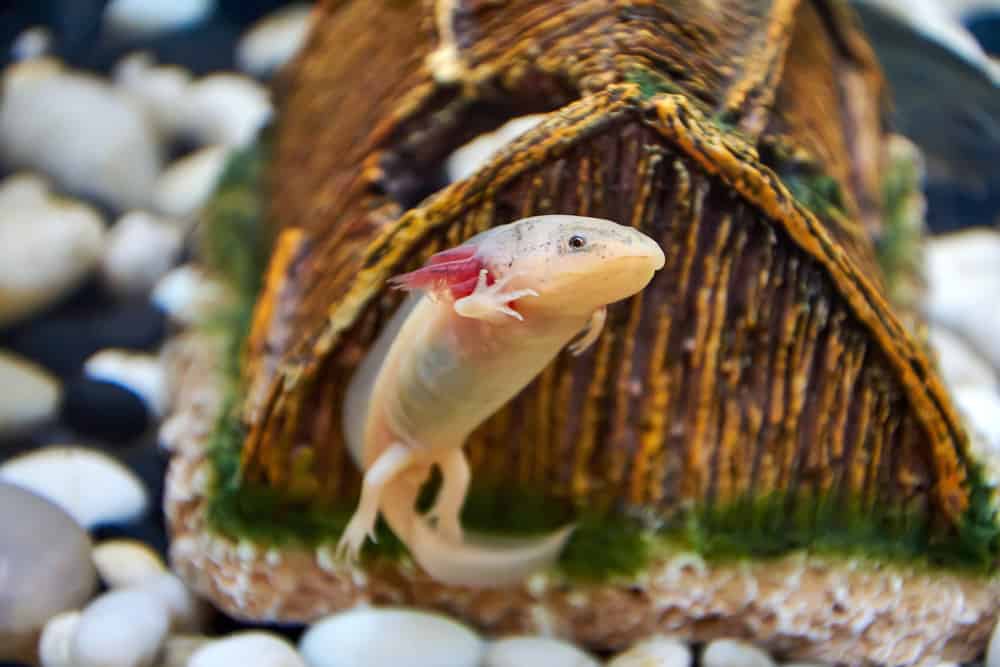
Having a good deep substrate adds to an axolotl’s security, but they also need places to shelter.
Real or artificial plants help provide the cover that these animals need. If you use real plants, use low-light species, and a dense mat of floating plants.
This is crucial since axolotls have sensitive eyes.
Artificial plants are a much easier choice, and you can choose from silicone, plastic, or silk varieties. You don’t need to worry about giving them light, and they don’t need fertilizer.
Give your axolotl at least two hides so that it has somewhere to go if it needs a sense of security.
You can buy aquarium caves, stack pieces of slate to make an axolotl motel, or turn a clay flower pot on its side.
If you decide to use slates, glue them together with a non-toxic silicone so they don’t fall on your pet.
Axolotl Lifespan
Axolotls live short lives compared to many other exotic pets. The average lifespan in captivity is around 10 years.
If you take excellent care of your axolotl, you can expect it to live for 10 to 15 years. Exceptional cases may reach ages of more than 20 years.
Some sources say that wild axolotls generally live for around 5-10 years.
However, other sources claim that they may live nearly as long as captive-raised animals. The truth is, thanks to their rarity and fractured populations, we can’t be 100% sure.
Mexican Walking Fish Temperament
Mexican walking fish are skittish but peaceful.
If you’re looking for a cuddly pet, this animal isn’t for you. Axolotls aren’t true pets, they’re more display animals.
Despite the many myths about these animals, they’re docile. An axolotl will run or swim away when confronted, rather than show aggression.
Never pick an axolotl up by its tail, leg, gills, or another body part. If you need to move your pet, scoop it with a soft aquarium net, and place it in a container of water.
The axolotl won’t attack you, but you may seriously injure it if you try to pick it up. Again, these are peaceful animals, but you can’t pet them.
Axolotl Pet Price
Axolotls breed readily and have a hardy nature. Thanks to these traits, they’re relatively inexpensive.
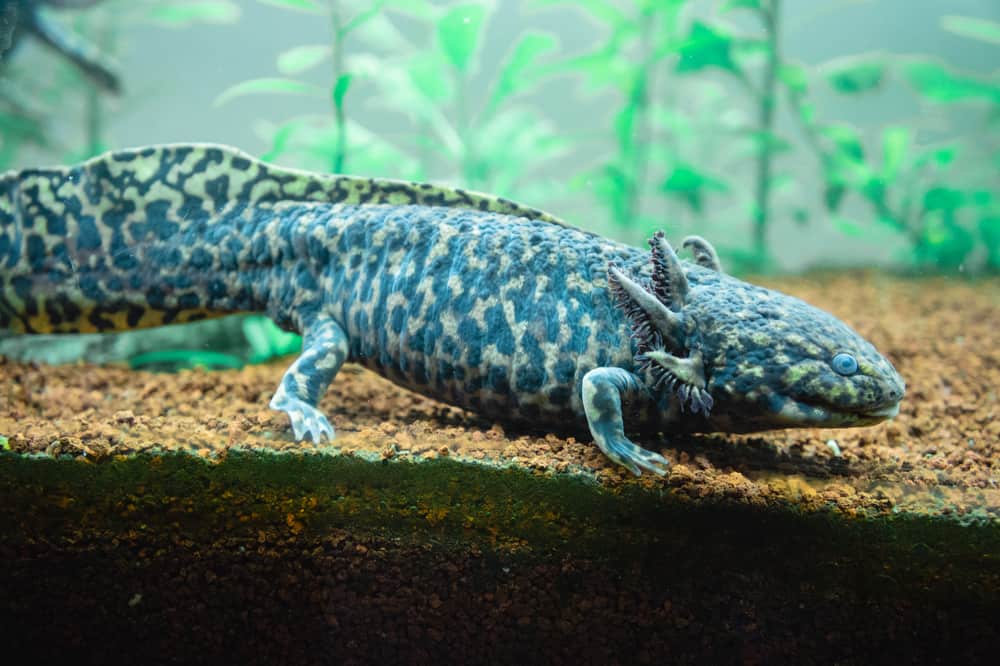
You can expect an axolotl pet price of anything between $40 and $70 for a basic axolotl morph.
Prices for morphs can vary significantly. For example:
- $1500 – Enigma
- $250 – Firefly
- $115 – Lavender
- $65 – Black
- $50 – Golden albino
- $45 – Leucistic
- $40 – Wild-type, White albino
The price will vary based on how many breeders are producing the morph, how much demand there is, and whether it’s a rare morph.
Where to Buy an Axolotl Pet
There are many different places where you can buy an axolotl.
Most reptile conventions (Repticon) or expos have axolotl breeders. Visiting your nearest expo is an excellent way to track down axolotls.
The Repticon organizers check the breeders thoroughly to ensure that they’re trustworthy.
Before you drive to a convention, check your local legislation. Not all US states allow people to keep axolotls. Some allow you to have them, but you can’t import them.
Check that you’ll be able to keep the axolotl if you buy it, otherwise you might not be able to bring it home.
Online stores are another excellent option and many breeders sell axolotls online. If you’re unsure about the quality of a specific breeder, ask fellow hobbyists on forums.
Most keepers will be happy to tell you about their experiences with breeders. Some may also breed axolotls themselves, and be willing to share some tips and tricks.
Finally, don’t forget to check out the axolotl-specific market websites.
It’s best to avoid buying animals from general listing sites, as you don’t know the quality of the animals and breeder.
Are Axolotls Illegal to Own?
Axolotls are legal in the United States, but not in all states.
So, can you have a pet axolotl? It’s always a good idea to check the local legislation before buying a new animal, whether that’s an axolotl or another species.
While keeping axolotls is legal in most of the US, several states have placed regional bans on the species. This is because some states struggle with invasive populations, while others don’t.
States where keeping an axolotl is illegal include:
- D.C.
- Maine
- Virginia
- California
- New Jersey
Other states require a permit to keep these animals. New Mexico and Hawaii are among them.
In yet other regions, you can have axolotls but you can’t import them across state lines.
In truth, the only safe option is to contact your state conservation office and find out for yourself.
Are Axolotls Good Pets?
These amazing animals make great pets.
They’re display animals rather than the traditional, cuddly pet, but they’re fun to have around.
As long as you keep their water quality high and feed them regularly, axolotls are placid and enjoyable.
Many keepers love to watch their axolotls chase after worms on their short stubby legs. They’re also named after a god, which adds to their appeal.
Can You Pet an Axolotl?
No, you cannot pet an axolotl. These animals are like fish or salamanders: look but don’t touch.
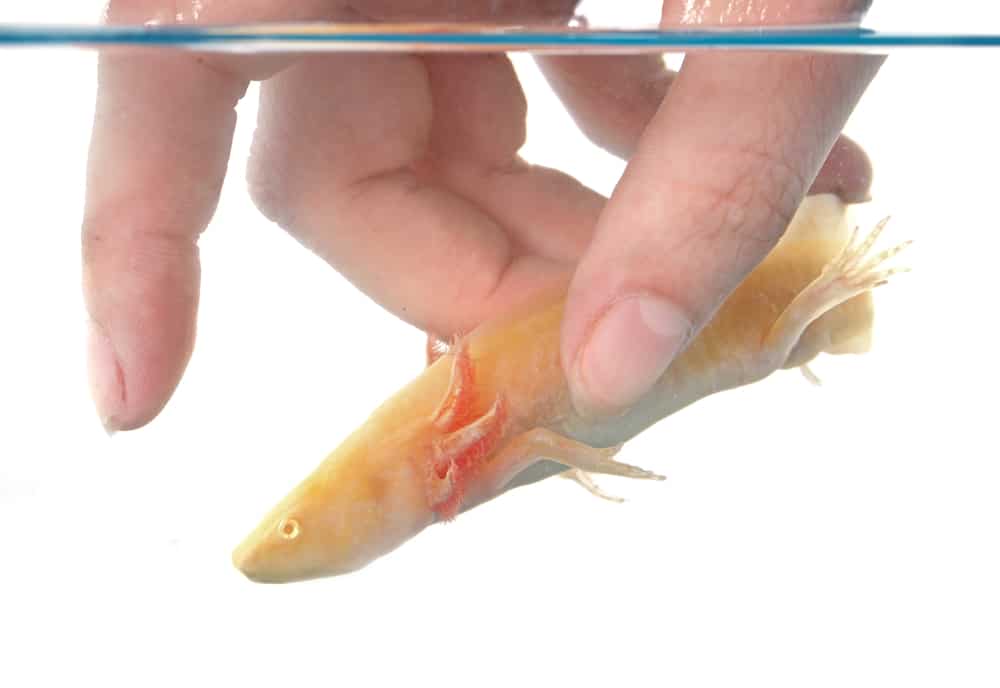
If you want an amphibian that will interact with you, you might want to consider something like a Pacman frog.
Axolotls may learn to recognize that your presence means food, and stop trying to hide away when you’re around.
However, they’ll never be cuddly pets, and you’ll have to settle for watching their amusing antics.
Can You Keep Multiple Axolotls in the Same Tank?
No, you can’t keep multiple axolotls in the same tank. At least, we wouldn’t recommend it.
These animals are highly carnivorous and have strong cannibalistic tendencies. Anything you place in your axolotl tank will be considered live food.
Axolotls happily eat small fish and larger fish nibble at their fleshy gills. If you keep more than one axolotl in the same enclosure, the larger animal will eat the smaller one.
If one animal can’t eat the other, they’re happy to take bites out of each other.
Unless you’re planning on breeding your axolotl, you should keep it separate from other fish and amphibians.
We hope you’ve enjoyed this article about keeping axolotls. Be sure to check out our other amphibian-related content for more fun articles.
Do you have an axolotl? If so, does it have a name? Let us know in the comments.
